My OpenLearn Create Profile
- Personalise your OpenLearn profile
- Save Your favourite content
- Get recognition for your learning
Already Registered?

Communicable Diseases
If you create an account, you can set up a personal learning profile on the site.

Figure 20.5 the life cycle of HIV. (a) HIV binds to proteins located on the surface of the target cell, in this case a CD4 lymphocyte. (b) HIV enters the cell, changes its structure and becomes part of the genetic material of the infected cell. (c) Many copies of HIV’s genetic material are produced inside the cell, together with viral proteins necessary to construct more viruses. (d) HIV’s genetic material and proteins assemble at the surface of the cell, and millions of new viruses are released outside the cell, where they can infect other CD4 lymphocytes. (Diagram adapted by: Drs Aschalew Endale and Ignacio Romero, from Participants Manual, WHO/IMAI, Integrated Management of Adolescent and Adult Illness, Basic Clinical HIV Care, ART and Prevention Training Course, 2007)
For further information, take a look at our frequently asked questions which may give you the support you need.
If you have any concerns about anything on this site please get in contact with us here.